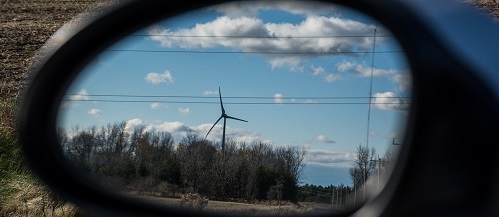[vc_row css=”.vc_custom_1554478283245{padding-top: 25px !important;}”][vc_column][vc_column_text]Foreword
In recent years, the renewable energy sector has been subject to shifting government policies, fast technological advancements and intense competition, all of which have made adaptation the necessary currency for corporations’ survival. As companies embark on setting strategic directions for their future, the key question being: is there a framework that can guide future efforts and investments in the renewable sector? There may be no straightforward answer to the above question, but this article, nonetheless, makes an attempt. [/vc_column_text][/vc_column][/vc_row][vc_row css=”.vc_custom_1554432856616{padding-top: 50px !important;}”][vc_column][vc_column_text]A Chasm of Inertia
Do you think renewables are good for the environment? Would you switch to renewable electricity today? Responses by electricity consumers on the first question is unanimous. On the second question though, responses resemble a page from Where’s Waldo. We know what is right, but to act on it, we run up against a chasm of inertia. What causes this inertia of consumer inaction towards renewable energy? This somewhat philosophical question hung over two pints of beer and between myself and my then colleague Tom Dean in Houston, Texas late 2018. While ping ponging ideas, Tom made a passing reference to Maslow’s hierarchy of needs, and my mind exploded. Is there a hierarchy of needs as it relates to electricity consumption?[/vc_column_text][/vc_column][/vc_row][vc_row css=”.vc_custom_1554433516666{padding-top: 50px !important;}”][vc_column][vc_column_text]The Oft Forgotten Blind Spot
In my previous role as a wind turbine vendor at ENERCON, a German wind turbine manufacturer, I had the opportunity to fuel some of the build out of wind farms in Canada. Wind power in Canada now exceeds 12+GW of generation producing enough electricity to power over 4 million households with the lowest impact to the environment. Unfortunately, this amazing achievement continues to receive minimal fanfare with the general populace. Why is this the case? It is my belief that renewable energy has a critical obstacle to overcome.
The crux of the matter is this: the end-users of our sector are ultimately paying for electricity and not clean air. They are looking to power their appliances and not necessarily to slow down climate change. It is the blind spot that we know exists, yet one that we rarely acknowledge or address. Today, the benefits of renewable energy lie beyond the horizon of everyday challenges of the general populace. This needs to change.
“Today, the benefits of renewable energy lie beyond the horizon of everyday challenges of the general populace. This needs to change.”
How can the sector provide a tangible connection between the benefits of renewable energy and the end consumers? I believe the concept of Maslow’s hierarchy of needs can offer some insight.[/vc_column_text][/vc_column][/vc_row][vc_row css=”.vc_custom_1554432870601{padding-top: 50px !important;}”][vc_column][vc_column_text]The Beginnings of a Theory
The premise of Abraham Maslow’s theory is that human motivation to satisfy various needs can be classified into distinct levels. The more basic physiological needs, such as food and shelter, form the lower level needs. It is only upon fulfillment of these lower level needs that we are motivated to satisfy those found within the next level up. In short, if I had been hungry, I may not have been motivated to write this article.
So what is hunger in the context of an electricity consumption hierarchy? To be blunt, it’s not renewable electricity. If we were to ask ourselves what we look for when it comes to electricity, there will most likely be some bewilderment. Who gives much thought to electricity anyway? It is just there or, at least, it better be there. Aha! Therein lies “hunger’s” counterpart: “availability”. First and foremost, we need electricity to be available.
Having grown up in Bangladesh, I was thankful that electricity was even available. We did experience frequent power outages; a source of constant inconvenience. The question usually was how long would the power last and not how long is the outage. Here in Canada, the situation is quite different but the same principle of inconvenience holds. No one likes to be in the dark, cold or hungry. Ultimately, we need electricity to be available in the right form at the right time. Electricity needs to be reliable. Availability and reliability of electricity form the bedrock of our energy needs.
“No one likes to be in the dark, cold or hungry. Ultimately, we need electricity to be available in the right form at the right time.”
The power outage days may in the past for me as I currently reside in Ontario where I face a different challenge. That of high price for electricity. The interesting bit though is that my friends in Montreal complain about their hydro cost as well, despite Quebec’s rates being significantly lower. What is then the common denominator for these complaining consumers? Well, both have their availability and reliability needs met by their utilities. Cost must therefore be at a higher level in the electricity needs framework.
Yet, one can argue that renewable energy in the form of solar rooftop, can actually lower your electricity cost over time. The most rational choice is to deploy rooftop solar. But we are human, and we demand everything to be simple and convenient. Current rooftop solar technology is not convenient, and I hope that will change quite soon. Bottom line, cost is a critical decision maker but we must not underestimate the value of convenience.
This framework for availability, reliability, cost and convenience (say in the form of a pyramid, henceforth the ARCs pyramid) determines the electricity consumption decisions of consumers. One can even apply this concept to consumption behaviour for other forms of energy such as fuel and food. Think of the levels of the ARCs pyramid the next time you are paying for a sandwich at an airport or gas at a remote fuel station. The ARCs pyramid may be sufficient to dictate our purchasing habits, that is, until the time our children tell us to choose environmentally friendly options for their future’s sake.[/vc_column_text][/vc_column][/vc_row][vc_row css=”.vc_custom_1554432884711{padding-top: 50px !important;}”][vc_column][vc_column_text]Here They Come
On that note, let me introduce the readers to the consumers (and voters) of tomorrow. Some time ago, I had the good fortune of giving presentations on wind energy to Grade 6 and Grade 10 students at a school in northern Quebec. Those 6thgraders were a tour de force! Their questions were insightful and their passion, infectious. In 2016, a few colleagues and I organized a Green Energy Doors event where we live-streamed to a classroom, drone footage of the tallest wind turbines in Ontario at the time (124m hub heights). We had a fantastic Q & A session as we started up a wind turbine while giving the students an up close view of turbine blades pitching in. There was palpable excitement amongst the students and the feedback from the teacher was humbling. In 2017, together with my then colleague Lauren Scott, I helped initiate energy consumption workshops in collaboration with the WE organization at three schools in Ontario. The student feedback from the workshops was a definitive “yes” to actively participate in environmentally friendly options for electricity. Simply put, opting to use renewable energy is an obvious choice for this next generation. It is my belief that the youth of today inherently have another level in them when they will face energy consumption decisions and that is their sense of impact on the wider Community. Is what I am using good for the Community?
“It is my belief that the youth of today inherently have another level in them when they will face energy consumption decisions and that is their sense of impact on the wider Community.”
[/vc_column_text][/vc_column][/vc_row][vc_row full_width=”stretch_row” content_text_aligment=”center” css=”.vc_custom_1554652263980{padding-top: 75px !important;}”][vc_column width=”1/4″][/vc_column][vc_column width=”1/2″][eltdf_elements_holder holder_full_height=”no” number_of_columns=”one-column” switch_to_one_column=”” alignment_one_column=”center”][eltdf_elements_holder_item hover_animation=”no” horizontal_alignment=”center” item_padding_1367_1600=”10px 0 10px 0″ item_padding_1025_1366=”10px 0 10px 0″ item_padding_769_1024=”0px 10px 0px 10px” item_padding_681_768=”0px 10px 0px 10px” item_padding_680=”0px 10px 0px 10px”][eltdf_single_image enable_image_shadow=”no” image=”5084″ image_size=”large”][/eltdf_elements_holder_item][/eltdf_elements_holder][/vc_column][vc_column width=”1/4″][/vc_column][/vc_row][vc_row css=”.vc_custom_1554432905176{padding-top: 50px !important;}”][vc_column][vc_column_text]On Building Pyramids
Thinking back on this ARCs pyramid, one can easily conclude that renewable energy hits the home-run at the Community level. It has also done well, recently, at the Cost level. That said, how realistic is it to build a pyramid, a stable structure, top down? This disconnect, in my view, is the source of the chasm of inertia among consumers. For renewable energy to truly resonate with the needs of the electricity consumer, it must offer the full package. Renewable energy has to conclusively solve the “Availability and Reliability” and “Convenience” levels. Only then can it expect to connect with consumer’s needs and values and truly become mainstream.
“How realistic is it to build a pyramid, a stable structure, top down? This disconnect, in my view, is the source of the chasm of inertia among consumers.”
The concept of the ARCs pyramid is by no means revolutionary – it can be argued that this concept is an adaptation of the consumer decision making process. However, as renewable energy generation removes its training wheels of government policy, it must better assess and address the needs of the energy consumer. The ARCs pyramid can thus be a simplistic way of highlighting focus areas for evolution of renewables in order to cater to such needs. Finally, we see the sense of Community is strong within our young consumers and it may very well be that Community impact usurps Cost as a more fundamental need down the road.[/vc_column_text][/vc_column][/vc_row][vc_row css=”.vc_custom_1554432942160{padding-top: 50px !important;}”][vc_column][vc_column_text]And Towards Leap Advancements
If we think of the pace of technological advancements in any sector, there are really only two gears – slow and ridiculously fast. I call them the creep and the leap. A good example of leap advancements is high speed wireless communication (LTE, Wi-Fi etc.). Within the span of a few years, LTE & Wi-FI have become the leading forms of information delivery edging out print magazines and newspaper. Could the ARCs theory give us hints regarding areas of leap advancements in the renewables space? I think so. Progress on the storage and demand side management represent the beginnings of such leap advancements.
While it’s nice to have theories and ideas, it’s more important to validate (or invalidate) theories, and act on ideas. This is the goal of our current efforts at Adaptive Renewables (ADAPTR). Can we give the energy consumers their right ARCs, and spur knowledge into action?[/vc_column_text][/vc_column][/vc_row][vc_row css=”.vc_custom_1554432952886{padding-top: 50px !important;}”][vc_column][vc_column_text]Afterword
The ARCs framework is an attempt to express truths about the energy consumers. Truths that drive consumers towards products they can value. The ARCs framework is also a work in progress and I wanted to put this concept out there for my peers to discuss and debate. If you have suggestions and questions on the content of this article, do reach out. I would love to hear from you.[/vc_column_text][/vc_column][/vc_row][vc_row disable_element=”yes” css=”.vc_custom_1579205408624{padding-top: 50px !important;padding-bottom: 100px !important;}”][vc_column][eltdf_elements_holder holder_full_height=”no” number_of_columns=”two-columns” switch_to_one_column=”768″ alignment_one_column=”” background_color=”#fafafa”][eltdf_elements_holder_item hover_animation=”no” vertical_alignment=”top” item_padding=”0px 15px 15px 15px” item_padding_680=”0px 15px 15px 15px” item_padding_681_768=”0px 15px 15px 15px” item_padding_1025_1366=”0px 15px 15px 15px” item_padding_1367_1600=”0px 15px 15px 15px” item_padding_769_1024=”0px 15px 15px 15px”][vc_column_text]
Back to Perspectives
[/vc_column_text][/eltdf_elements_holder_item][/eltdf_elements_holder][/vc_column][/vc_row]


